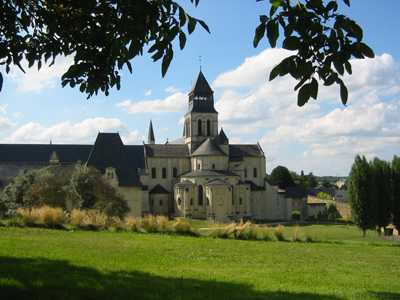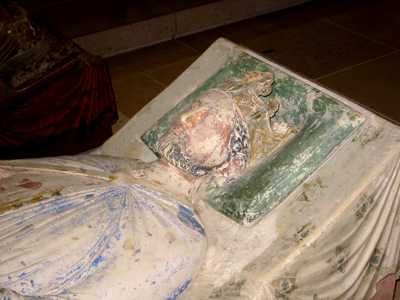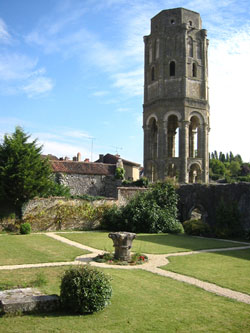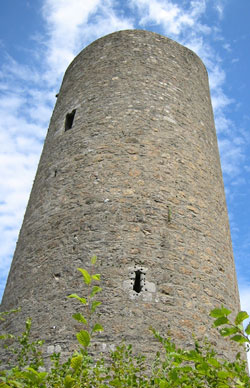 As he lay slowly dying of a gangrenous wound in the Limousin region of France in 1199, Richard The Lionheart expressed to his mother, Eleanor of Aquitaine, his final wishes regarding his burial: ‘My corpse will be buried in Fontevraud, my heart in my cathedral of Rouen, and my entrails will stay in Chalus.’
As he lay slowly dying of a gangrenous wound in the Limousin region of France in 1199, Richard The Lionheart expressed to his mother, Eleanor of Aquitaine, his final wishes regarding his burial: ‘My corpse will be buried in Fontevraud, my heart in my cathedral of Rouen, and my entrails will stay in Chalus.’
The peculiar circumstances surrounding Richard’s death and dying wishes have inspired countless myths and legends over the intervening centuries. But what exactly led this legendary English king to utter these words? Why did he want to have his body scattered across France? And why these three places? To answer these questions, I decided to embark on a modern-day quest for the medieval Richard, and to use his own dying wishes as a roadmap.
I began my quest where Richard’s life had ended: Chalus. If Richard had died at a castle in England, the place would certainly be a major tourist attraction selling everything from plastic swords to Excaliburgers. But Richard died in a small town in the middle of the remote Limousin countryside, in lands that would later become foreign to the English. So not only is the castle of Chalus privately owned, but—sadly for a site of such historical significance—it is currently closed to the public.
Fortunately, however, I’d made prior arrangements with the amenable owner of the castle—who was away, but didn’t mind me poking around. So as I walked through the open gates, I suddenly found that I had the castle where the legendary Richard the Lionheart met his end all to myself. It was an extraordinary moment for someone who has long been fascinated by Richard and the Plantagenets.
 Approximately eight hundred years earlier, in the early evening of March 26th 1199, Richard approached the fortifications of Chalus on horseback. Some chroniclers say he was inspecting the work of his sappers who were trying to undermine the castle walls; others say he wished to practice his bowmanship and take a few shots at the meager garrison in the keep. One of the castle’s few defenders—according to most accounts, the castle was only defended by two knights and some servants of the Viscount of Limoges—took advantage of Richard’s recklessness.
Approximately eight hundred years earlier, in the early evening of March 26th 1199, Richard approached the fortifications of Chalus on horseback. Some chroniclers say he was inspecting the work of his sappers who were trying to undermine the castle walls; others say he wished to practice his bowmanship and take a few shots at the meager garrison in the keep. One of the castle’s few defenders—according to most accounts, the castle was only defended by two knights and some servants of the Viscount of Limoges—took advantage of Richard’s recklessness.
Named by most chroniclers as Pierre Basile, the crossbowman—who earlier in the day had been fending off the arrows of Richard’s men with a frying pan, to the considerable amusement of Richard and his men—fired in the king’s direction. Richard applauded the crossbowman’s audacity. Another bolt, however, soon struck the king in the left shoulder near the neck. Not wishing to alarm his men or reveal the extent of his injury to the defenders of Chalus, Richard offered a chivalrous salute to Basile for his marksmanship and returned to his tent. He tried to remove the bolt himself, but the wooden shaft broke off, leaving the iron head inside. In poor light a surgeon finally removed the head of the bolt, but made the wound worse in the process. The wound became infected, and gangrene set in.
 In the days that followed, Richard bequeathed his realm to his brother John, pardoned the crossbowman responsible for his wound and gave the instructions regarding his burial. Twelve days after receiving his injury, and with his beloved mother Eleanor of Aquitaine at his side, Richard died in Chalus. For the defenders of Chalus, Basile’s marksmanship earned them a grisly fate. Just days after Richard’s injury, and inflamed by the wounding of their king, his men stormed the castle and hung the men and women inside. The only exception was Basile, who—in spite of Richard’s deathbed pardon—was, after the king’s death, flayed alive and then hung.
In the days that followed, Richard bequeathed his realm to his brother John, pardoned the crossbowman responsible for his wound and gave the instructions regarding his burial. Twelve days after receiving his injury, and with his beloved mother Eleanor of Aquitaine at his side, Richard died in Chalus. For the defenders of Chalus, Basile’s marksmanship earned them a grisly fate. Just days after Richard’s injury, and inflamed by the wounding of their king, his men stormed the castle and hung the men and women inside. The only exception was Basile, who—in spite of Richard’s deathbed pardon—was, after the king’s death, flayed alive and then hung.
Today, of course, there’s no tangible sign of all the blood spilled at Chalus eight hundred years earlier, and much of what Richard would have recognised as the castle has fallen into ruin. However, in addition to some of the outer castle walls and parts of the 11th century chapel—where a modest effigy of Richard lies in the open air, surrounded by wild grass and crawled upon by the occasional disrespectful salamander—the impressive round keep from which Basile is believed to have fired the mortal crossbow bolt remains very much intact.
 Chroniclers offer conflicting accounts about whether Richard’s entrails were buried at the foot of the keep or in the chapel at the site of his effigy. In either case, Richard’s choice to have his entrails buried in Chalus was a final act of defiance towards the ever-rebellious people of the Poitou region. According to Matthew Paris, one of Richard’s most reliable chroniclers, he asked that his entrails—‘the receptacles of his excrement’—remain in the region for the people’s perfidy against him, and because he thought they did not merit a more dignified part of his body.
Chroniclers offer conflicting accounts about whether Richard’s entrails were buried at the foot of the keep or in the chapel at the site of his effigy. In either case, Richard’s choice to have his entrails buried in Chalus was a final act of defiance towards the ever-rebellious people of the Poitou region. According to Matthew Paris, one of Richard’s most reliable chroniclers, he asked that his entrails—‘the receptacles of his excrement’—remain in the region for the people’s perfidy against him, and because he thought they did not merit a more dignified part of his body.
But the historical Richard—as opposed to the romanticised Richard of legend—remains an elusive figure: even the exact location of his intestines is a subject of active dispute. In what may be nothing more than an example of savvy medieval marketing, Charroux Abbey in the Charente region also lays claim to Richard’s entrails—and to his brain. Eleanor of Aquitaine is believed to have stopped at Charroux while transporting Richard’s body to Fontevraud, and this visit may have given birth to the story.
Founded by Charlemagne, Charroux Abbey was very important in Richard’s time, and was particularly renowned for its relics, so it’s not inconceivable that a king as convinced of his own self-importance as Richard would wish to leave his mark among the relics of the saintly and benighted luminaries there. But as the abbey was severely damaged in the struggle between Catholics and Huguenots during the 16th century Wars of Religion, and was later sold off and used as a quarry after the French Revolution, the story has been impossible to verify.
 There’s no doubt, however, about the interment of Richard’s heart in Rouen Cathedral in Normandy, the next stop on my quest for Richard. One need only look at the statue of Richard I outside of the Houses of Parliament in London to appreciate the central place he holds in the historical consciousness of the English nation. But because he was an English king, in France his legacy is much more ambivalent. So I suppose I shouldn’t have been surprised to learn that—apart from a modest Latin inscription—Richard’s tomb in Rouen Cathedral bears no sign announcing to unaware tourists that they’re walking past a medieval legend.
There’s no doubt, however, about the interment of Richard’s heart in Rouen Cathedral in Normandy, the next stop on my quest for Richard. One need only look at the statue of Richard I outside of the Houses of Parliament in London to appreciate the central place he holds in the historical consciousness of the English nation. But because he was an English king, in France his legacy is much more ambivalent. So I suppose I shouldn’t have been surprised to learn that—apart from a modest Latin inscription—Richard’s tomb in Rouen Cathedral bears no sign announcing to unaware tourists that they’re walking past a medieval legend.
Of course, the heart itself—described by one contemporary chronicler as ‘abnormally large’—has long since turned to dust. But Richard’s well-preserved tomb remains, as does the box—bearing the inscription ‘Hic Iacet Cor Ricardi Regis Anglorum’ (Here Lies the Heart of Richard, King of the English)—which was used to transport his most notorious organ the hundreds of miles from Chalus to Rouen. According to Matthew Paris, Richard wanted his heart buried in Rouen as a token of his love for the city, and in recognition of the fierce loyalty of its inhabitants.
After looking for Richard in the Limousin, the Charente and Normandy, it was time to move on to my final destination: Fontevraud, near Chinon, in the Loire Valley. After Richard’s death, and once his intestines, heart, and—if the claims of Charroux are to be believed, his brain—had been removed, what was left of the king was laid to rest at his father’s feet in Fontevraud Abbey. The abbey has long been associated with the Plantagenet dynasty. It was the burial site not only of Henry II and Richard I, but also of Eleanor of Aquitaine, Richard’s sister Joan of England, Isabelle of Angoulême (wife of Richard’s brother, John Lackland, who was to succeed him as King of England), and the hearts of both King John and his son King Henry III.
 But the rich royal heritage of Fontevraud came about almost by accident. Although both Henry II and Eleanor had been generous patrons of the abbey, Henry had actually asked to be buried at Grandmont Abbey in the Auvergne region. However, Henry died at his fortress of Chinon in the full heat of July, and due to the rapid decay of his body was buried at Fontevraud. Although Richard had quarrelled with his father for most of his adult life, upon Henry’s death he had repented, and—remorseful over his role in his father’s death—asked to be buried at his feet. Thus began, by an accident of timing and weather, the tradition of the Plantagenet family burials at the abbey.
But the rich royal heritage of Fontevraud came about almost by accident. Although both Henry II and Eleanor had been generous patrons of the abbey, Henry had actually asked to be buried at Grandmont Abbey in the Auvergne region. However, Henry died at his fortress of Chinon in the full heat of July, and due to the rapid decay of his body was buried at Fontevraud. Although Richard had quarrelled with his father for most of his adult life, upon Henry’s death he had repented, and—remorseful over his role in his father’s death—asked to be buried at his feet. Thus began, by an accident of timing and weather, the tradition of the Plantagenet family burials at the abbey.
After the decline of the Angevin kings, and the eventual English loss of western France to the French kings at the end of the Hundred Years’ War, the abbey’s importance waned, and it fell into disrepair. For more than 150 years—between 1804 and 1963—it even served as a prison. Today Fontevraud is one of the largest restoration sites in France, and also has the country’s largest collection of monastic buildings. But the principal draw to the abbey remains the four surviving Plantagenet effigies of Henry II, Eleanor of Aquitaine, Richard and Isabelle of Angoulême.
Richard’s parents Henry and Eleanor—who are believed to have harboured a genuine affection for each other before later coming to despise one another—repose peacefully side by side, suggesting a marital serenity that belies the often cruel reality of their tumultuous union. At their feet reclines King Richard the Lionheart, certainly the most remarkable fruit of that union—the great crusader king, military genius, fearless warrior and flawed knight, whose exploits were to inspire legends that still resonate through the centuries.